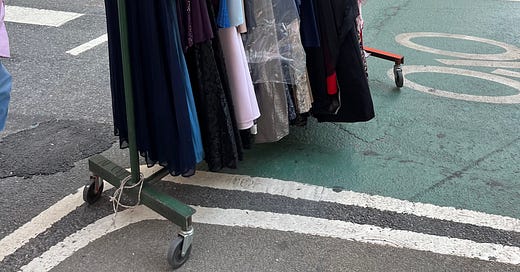In recent years, fast fashion has become an alarming trend, with consumers increasingly turning to brands like Shein despite the evident harmful effects. This phenomenon is not only devastating to the environment but also detrimental to the fashion industry as a whole.
Traditionally, the fashion trend cycle repeats every 20 years, allowing styles to evolve and return with a new twist. However, the rapid pace of fast fashion has accelerated this cycle dramatically, leading to a constant churn of fleeting trends and disposable garments. This unsustainable approach is causing significant environmental damage and undermining the essence of creative fashion innovation.
I know we've all seen the TikTok videos exposing how brands like Jaded London and Princess Polly use the same manufacturers as Shein, yet charge significantly higher prices. While this might make it seem like shopping at Shein is a savvy financial choice, it's crucial to recognize that it doesn't excuse supporting a brand with such unethical practices. Shein has been accused of child labor, operates unregulated factories, and stands at the forefront of the fast fashion movement. Not a flex.
Personally, one of my favorite things about fashion is owning unique pieces that no one else has. What happened to the joy of individual style? Why does everyone suddenly want to wear the same thing? That’s a whole other article on its own ;), but it underscores a key point: fast fashion is stripping away the individuality and creativity that once defined personal style.
As the industry grapples with these challenges, it's crucial to reflect on the impact of our purchasing decisions and advocate for more mindful, sustainable fashion practices. With that said, here are three tips I’m personally using to become a more sustainable shopper:
Buy Secondhand.
This one might seem obvious to some, but it is one of the most effective ways to be a more sustainable shopper. By purchasing pre-loved clothing from thrift stores, consignment shops, or online resale platforms, you contribute to reducing waste and extending the lifecycle of garments.
My favorite part about shopping secondhand is the endless possibility of what you may find and there’s truly a secondhand spot for everyone. If you’re just starting out, thrift stores are a treasure trove of unique, vintage, and high-quality items that you might not find in regular retail stores. If you’re more into designer pieces, consignment shops often carry gently used, high-end fashion pieces at a fraction of their original price, making it possible to afford luxury items without the hefty price tag. If you love the convenience of online shopping, online platforms like Poshmark, Depop, and ThredUp have made secondhand shopping more accessible than ever, allowing you to browse various styles and sizes from the comfort of your home.
No matter your preference, secondhand shopping offers a unique and sustainable way to explore fashion and find one-of-a-kind pieces that reflect your personal style.
Quality over Quantity.
Why have more when you can have better? By investing in high-quality, durable pieces, your clothes last longer and stay in style, giving you a wardrobe that will always look chic. This not only saves you money over time but also helps the environment by cutting down on textile waste and the demand for fast fashion.
Quality garments are made from better materials and craftsmanship, offering that timeless style that doesn't fade with the latest trends. Plus, you're more likely to support brands that care about ethical production practices, which is always a plus. On top of that, high-quality clothes simply feel better. They fit well, look fabulous, and give you that extra boost of confidence.
By choosing quality over quantity, you’re treating yourself to superior fashion while positively impacting the planet and supporting the people who create your clothes.
Hot People do their Research.
Wouldn’t you like to know where your clothes come from? Or at least if they have a cool origin story. By choosing companies that prioritize sustainable practices, ethical labor, and environmentally friendly materials, you can help drive positive change in the fashion industry. These brands reduce their environmental footprint through renewable energy, waste minimization, and recycling.
Ethical brands often use materials like organic cotton and recycled fabrics, reducing harmful chemical usage. Their transparency about supply chains fosters accountability and encourages industry-wide standards. Additionally, their high-quality products last longer, cutting down on the need for frequent replacements. These all sound like positives to me!
Supporting ethical brands is cool. In turn, you are advocating for a more sustainable and fair world. Your choices help these companies thrive, pushing the fashion industry toward more responsible practices.
Ultimately, the shift from fast fashion to more sustainable practices is not just a trend but a necessary evolution in the way we view and consume fashion. The rise of brands like Shein highlights the urgent need for change. By embracing practices such as secondhand shopping, prioritizing quality over quantity, and supporting ethical brands, we can collectively make a significant impact.
I know you might be thinking, "Ok, but if I change my behavior and no one else changes theirs, that's not going to make a difference." But here's the thing: it truly only takes one person to start a change and this change is necessary. Our purchasing choices have the power to steer the industry toward more sustainable and ethical standards, protecting the environment and encouraging creativity and individuality in fashion.
Now is the time to make conscious decisions that align with our values and contribute to a better future for both fashion and the planet. Let’s do this together.
XO,
𝒇𝒂𝒔𝒉𝒊𝒐𝒏 𝒇𝒊𝒍𝒍𝒆




Hi! 😊 Don't know if you might be interested but I love to write about sustainability (fashion, travel and our relationship with clothes). I'm a thrift shopping and vintage clothing lover who likes to explore the impact textile industry and consumistic culture have on the environment and also what people can do to shift the tendency.
• • •
https://from2tothrift.substack.com/